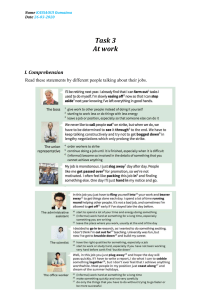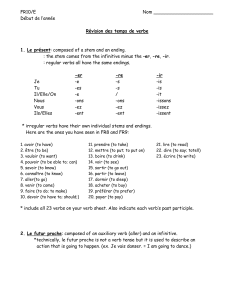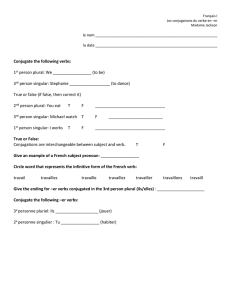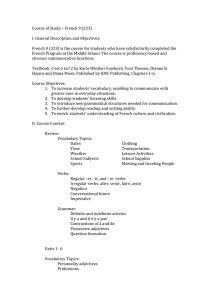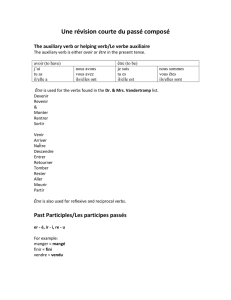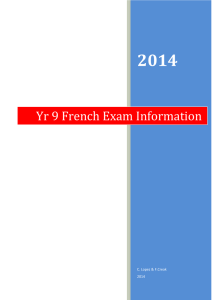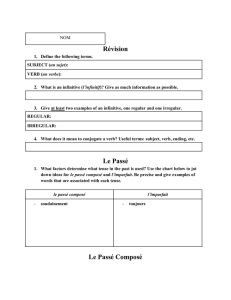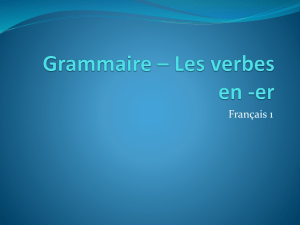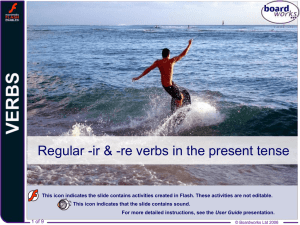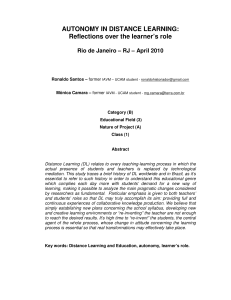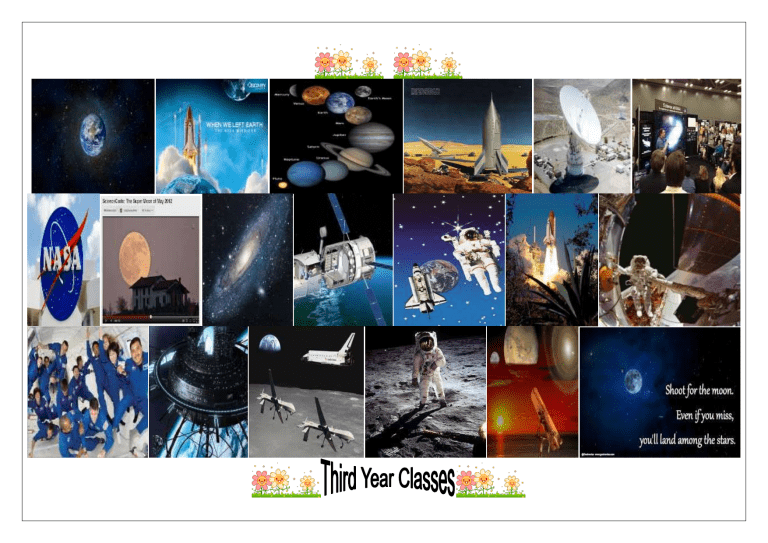
Course
Objective
Learning Objectives
Designing an astronomy booklet
Decipllinary
Competencies
Listen and Consider
* Interpretation
°Describing the
functions of objects
**Interaction
(used to/used for).
°Asking and answering
***Production
questions about
measurements.
°Forming singular and
plural nouns from
verbs.
°Recognizing and using
stress in two-syllable
verbs.
°Making an oral
presentation:
description of the
moon.
S.R .Sed
Activities
Getting Started
p136.
Let’s hear it p
137:
Tasks 1,2
Around the
text :
*Grammar
Explorer I
(Revision):
Tasks 1&2 p138
*Grammar
Explorer II
Tasks 1&2p
138/139
Vocabulary
Explorer
Tasks
1,2&3p139/140
Pronunciation
Resources
Integration
Materials
✾Grammar ✾
-“ New
Prospects”
- Used for /used to
-How far/how big
✾Vocabulary✾
-Vocabulary related to
measurement
✾Pronunciation✾
-Two syllables verbs
‘stress.
“Writing an
expository
presentation of
the Moon “
-Visuals
-The manual
scripts
(listening script
p 206)
and Spelling
Tasks:1,2&3 p140
Think ,pair,
share p140
Read and Consider
°Anticipating text
content
°Scanning for details
**Interaction
*Production
*Using comparatives
and superlatives of
**Interaction
superiority and equality
with shirt/long
*Production
adjectives and adverbs
*Expressing contrast
/describing similarities
and differences
*Making
hypothesis/suppositions
*Using non-conclusive
verbs.
*Forming plural nouns
*Pronouncing final “s”.
Getting Started
p142.
Tasks:1,2&3
Taking a closer
look p 142.
Task p 142.
*Grammar
Explorer I
(Revision):
✾Grammar ✾
-Comparatives
and
superlatives with short
and long adjectives.
• adjective+adj+than
• more +adj+than
• less +adj+than
•as+adj+as
-while, whereas, like
Tasks: 1&2 p 145. ,unlike ,in contrast to
-Think so , suppose so
*Grammar
- If-conditional.
Explorer II
(Revision):
Vocabulary
Tasks:1&2 p 146.
-Vocabulary related to
*Grammar
Explorer III
Task p 146.
Pronunciation
*Grammar
- Final ‘s’
Explorer IV
pronunciation
Task p 146/147.
Vocabulary
Explorer
✾
✾
Pronunciation
✾
✾
“Writing an
essay predicting
the
consequences
of a comet
collision with the
earth “
-“ New
Prospects”
-Visuals
-The manual
scripts
(reading
passage p 143)
-“ New
Prospects”
“Writing an
essay predicting
the
consequences
of a comet
collision with the
earth “
-Visuals
-The manual
scripts
(reading
passage p 143)
Reading and writing :
*Anticipating text
content
*Scanning for details.
*Identifying types of
discourse.
*Writing a news paper
article
Project Outcome.
*Designing an
astronomy booklet*
Assessment
To evaluate Ls abilities
and understanding
* Interpretation
**Interaction
***Production
*Production
*Interaction
**Production
and Spelling
Tasks: 1, 2, 3&4p
148
Before
Reading p156.
Tasks:1,2&3
As you Read p
157.
Tasks: 1 p157, 1,
2&3 p 158.
After reading
p 159.
Tasks:1&2
Writing
development
p160.
Task p 162
Language
assessment
Tasks 1 and 2 p163
Skills and
strategies
assessment
Text three p 262
✾Grammar ✾
-Types of discourse
✾Vocabulary✾
“Writing a
newspaper
article about
space
exploration”
- Synonyms and
antonyms
-“ New
Prospects”
-Visuals
-The manual
scripts
(reading
passage p 157)
Learners should exploit
the grammar and the
vocabulary notions they
have learnt.
-produce ID cards
of planets
-make a board
display of planets
-make posters of
planets
-write a junior
encyclopaedia on
the solar system
“ New
Prospects”
Tasks on grammar,
writing, and pronunciation.
“Written Expression
related to the chosen
text”
“ New
Prospects”
Personal
aids
Web sites
School: Mekkeoui L’aid /Bouchrahil.
Source: “New Prospect”
Stream: 3rd Year Scientific Stream.
Unit five : It’s A Giant Leap for Mankind
Project Outcome: Designing an Astronomy Booklet
Ti
Stages Rationa I.
Procedure
Obser
me
le
Patte
vation
rn
10
Warmin
T. greets her Ls and inquires about their daily school life.
mnts g up
T
and
To
T tries to brainstorm the topic of Astronomy and the solar system .T may
Ls
interact
write some famous quotes on the board then ask the class to whom these
about
words are attributed - “That’s one small step for man, but…(one giant leap
the
for mankind)”- “To be, or not to be:…(that is the question). She may help
theme
them by asking the following questions: Is he a writer? Is he a poet? T may
Ls
of the
ask them to translate the quotes into their language.
project
* Ls trie to answer * T listen and interact with Ls .She may show the Ls two
Task
pictures about the two persons .T tries to focus on Neil Armstrong .She may
15
T and
ask Ls about his nationality and his job. Here the word Astronomy is
mnts assigne
Ls
ment
introduced .Tcan use pictures of the earth, the sun, the moon and other
planets to elicit the theme of the unit.
* T asks Ls to open their books on page 162 and take a sheet of paper to
To
take notes.
discuss
*Ls respond.
20
about
*T asks Ls to divide themselves into groups of four.
mnts
the
*T explains the strategies to be followed to make the project:
project
-define the theme and determine the final outcome (Designing an
astronomy booklet).
Ls
- structure the project by identifying information they need to obtain it.
-explain language skills they need and ask them to gather information
needed to fulfill the project.
- ask them to compile and analyze information they gathered and decide how
to organize them for efficient presentation.
To
listen
and
Take
notes
The information they need to get:
A) ID cards about two major planets in our solar system.
B) ID cards about two major moons in our solar system.
C) A short presentation of their history of space travel.
D) A short imaginary dialogue with a famous astronomer /space traveler
E) A checklist of the effect of space travel and astronomy on human life
(technology, change of mentality ….)
F) Pictures /drawings of pieces of equipment used in astronomy.
Page 4
❀ Personal Goals:
➺ During this lesson, what teacher competencies are you focusing on? They should be adapted from the ATF to reflect the
specifies of your situation
Two-way communication with the world: English is a tool for communication that enable learners to make
connections with the world and communicate something
About one’s self ,community and country to others.
Communicative Competence: Communicative competence in English involves interacting with others using receptive / interpretive skills (reading
and listening) and productive skills ( speaking and writing ) , supported by the ability to use vocabulary and grammar appropriately and employ a range
of language strategies that help convey and clarify meaning.
❀ Lesson Focus:
➺ In this lesson I will teach the following aspects of language:
Function: Describing functions of objects/ asking and answering about measurements.
Grammar: Used to -used for / How far…..how big …..How long.
Vocabulary: vocabulary related to Astronomy and measurement.
Pronunciation: Stress shift in two-syllable words.
❀ Competencies: Which competencies in the AEF are you working toward or plan for the learners to achieve
today? They should be adapted from the
AEF to reflect the specifies of you lesson.
Can interact orally to start, maintain (e.g. greetings, asking questions and follow- up questions, answer in details, giving
and seeking facts, reasons, advice and opinions and agreeing and disagreeing) and close a conversation.
Can listen and understand main points and the important details longer monologs and conversations with two or three
people (over a minute).
Can produce an oral narrative or description.
❀Objectives /Assessment:
➺ SWBAT: by the end of the lesson, students will be able to make an oral presentation (description of the Moon)
❀ Required material and / or resources:
Pictures of the manual + additional pictures
The manual’s script p 206
Grammar reference p 222 .
Page 5
School: Mekkeoui L’aid /Bouchrahil
Stream: 3rd Year Scientific Stream
Source: “New Prospect”
Unit Five: It’s A Giant Leap for Mankind
Teacher: Mrs. .Chikhi .M
Listen and Consider {PDP Listening Lesson}
Ti
Stages
Rationale
I. P
Procedure
Observat
me
ions
To access
15mt Preview and
s
♠Pre-listening:
activate
-Brain storming
students’
The teacher may start the lesson by asking the Ls following questions:
backgroun
Do you like watching world cup? When and where was the last one
d and
organized? How can you watch it? How can TV transmit the ( )?
Getting knowledge
*T listens to Ls answers the invites them to go to p 136 and have a look
10
started of the
at the two pictures.
Mts
topic.
*T tries to interact with Ls about the questions in task p 136.
Ls
Key to task:
1- They represent satellites
To open
2- They are similar in the sense that they orbit the Earth.
discussion
3- They are different. One of them is a natural satellite and the other
5
Let’s
on the
is an artificial satellite.
mts
hear it
topic of
4- T. elicit as much information as you can.
the course T&Ls 5- Yes, Alsat .
Task one & unit in
♠During listening:
5mts p 137
general.
T invites Ls to read the sentences in the carefully, listen to the teacher
reading the script then re-order them using numbers in the table .
[VAKT= Manual’s script page 206]
5mts
To
train
ls
Key to Task :
Task two
to
listen
p
137
Jumbled
A B C
D
E F
10mt
for specific
s
sentences
details
Ls
order
4 3 1
6
2
Now Ls are invited to compare their answers with those of their partners
To
then listen again to part II of the script then answer task’s two questions. Page 6
evaluate
Key to Task :
the
A. It is 610 kms away from the Earth
learners
5mts
B. It is roughly cylindrical in shape.
comprehe
C. It is 13 m long.
nsion and
D. It weighs more than 11 tons.
5mts
get more
Gramm
T&Ls
5mts
ar
informatio Ls
Explore n from the
rI
oral script.
Ls
10
mts
Task one
p 137
To make
the pupils
observe,
analyse
and draw
the rules
For
expressin
g purpose
with used
to /used
for
5mt
♠Post -listening: The learners are asked to give their answers, and
then the teacher invites them to go to Grammar Explorer I and consider
the sentences.
Ls
Presentation:
*T asks Ls to read the sentences given in grammar Explorer I.
T&Ls
Isolation:
1-What are the satellites used for?
Interrogative sentence.
2-They are used for sending computer data.
Affirmative sentences
3-They are used to survey the earth and make weather forecasts.
Analysis: The learners are invited to analyze the following
statements.
They are used for sending computer data.
Subject + verb + used to + (send+ing)
object
Ls
To be
used to + verb +ing
☛expressing purpose
They are used to survey the earth.
10
mts
Subject + verb + used to + survey
To be
☛expressing purpose
10
mts
object
used to + verb
T
Page 7
Task one
p 138
5mts
5mts
10
mts
10
mts
20
mts
15
To
practice
expressin
g purpose
with used
for /used
to.
Ls
Ls
Task two
p 138
Ls
Stating rule :
When we describe the purpose of something , we use
one of the following structures
*It is used for +verb+ing
*It is used to +verb in the infinitive.
* We use only the preposition” for “when asking
questions about the purpose of objects (what is it used
for?)
T.should refer learners to grammar reference p 222 for more information
Practice :
After writing the stating rule the Ls are invited to do Task one & two p
138
Key to Task : (1.B) ( 2. C) ( 3. D) (4. A) (5.F) ( 6.E)
Now Ls are asked to use answers to task one to describe the telescope
and its functions orally.
Gramm
To make
ar
Explore the pupils
T&Ls
observe,
r II
analyse
Key to Task :
A telescope is an optical instrument .It magnifies pictures of faint
Task one and draw
the rules
p 138
and distant objects.The telescope is cylindrical in shape .It consists of a
about
case ,eyepiece lens and an object lens.The telescope is made of metal
asking
and glass and it is used for observing the stars.
Ls
and
At this stage T. Invites Ls to go back to the questions and answers in
answering
listening task two on p 137 then try to answer the questions that follow.
questions
Presentation:
about
*T asks Ls to read the questions given in task two p 137.
measurem Ls
Isolation:
ents.
A. How far is the Hubble Telescope from the earth?
It is 610 kms.
B.What is its shape?
It is roughly cylindrical in shape.
C.How long is it?
It is 13 m long.
D.How much does it weigh?
It weighs more than 11 tons.
mts
Task two
p 138
Analysis: The learners are invited to analyze and answer the
questions
-How
long
10
mts
15
mts
5
mts
15
mts
2
mts
far
is it?
is
Hubble Telescope? /
How
To
Ls&L
s
Wh question +adj +verb + subject
wh question+ adj of
practice
measurement+verb+subject
asking
Word
of measurement
and
Stating rule: To ask questions about
answering
dimensions, places and measurements, we
questions
use “how”+adj
about
measurem
Practice :Now Ls are invited to do Tasks one and two
ents
At this stage Ls are going to use the words in box to ask questions so as
T&Ls
they get information in bold type
Key to Task :
A. How much does Sputnik I/Sputnik 2 weigh?
B. How far is the moon from the Earth?
Task one
Ls
p 139
C. How long does it take our planet to make one revolution round the
sun?
D.How high is Mount Everest?
E. How tall was Yuri Garin?
F. How long … How wide - How deep…?
G. How fast does light travel?
Task two
p 139
Ls
T should motivate and encourage Ls to work in pairs tonask and answer
questions using the information in task one .
Task
three p
140
To differ
between
the
Ls&L
s
Page 8
15
mts
5
mts
10
mts
10
mts
different
words
which are
related to
measurem
ents
Ls
T. greets her Ls and inquires about their daily school life.T invites Ls to
go back to grammar explorer II (tasks 1&2) p 138, then pick out words
related to measurements and write them in the table.
Key to Task :
Verbs
Nouns
Adjectives
Weigh, takes, travel Height, weight,
High, tall, heavy,
length, depth.
long, wide, deep
Distance, speed.
Kilometres, metres.
Page 9
Hours, minutes,
To enrich
seconds
Ls
Now Ls are invited to do task two .They are going to match words on
vocabular
the left with their associated words on the right then try to use them in
y with
illustrative sentences.
words
Key to Task :
related to
(1.B ) ( 2. A ) (3.C) ( 4. E) (5. D)
measurem
At this stage Ls need to have dictionaries to find the singular and the
ents
plural nouns of verbs “prove”and “believe”.Ls are going to fill in the
blanks in the text with appropriate verbs or nouns to make it meaningfule
.
Verb
Singular noun
Plurl
Task one
p 140
Pro
Proof
To give Ls T&Ls Prove
Believe
of
s
Beli
Belifs
opportunit
f
y to
Key to Task :
practice
1. believed 2. Belief 3. Proved 4. Proof
forming
singular
For more understanding teacher may add an extra task as the
an plural
Ls&L following:
nouns.
s
Task: Complete the sentences with a noun form corresponding to
the verb given in parentheses.Then give their plural
Task two
p 140
1- (choose) Take whichever you like. It's your /4 - (disappoint) Book
early to avoid ……
2- (refuse) Their ….came as a big surprise./5- (fail) They haven't
experienced like this before……..
1o
mts
20
mts
15
mts
15
mts
T&Ls
To remind
Ls about
stress
pattern.
3- (deliver) They offer free…. to this area./6- (complicate) If there is
no… we can continue.
7- (confuse) There seems to be a lot…………..as to what these results
mean.
Page 10
To
recognize
the stress
in two –
syllable
verbs
Task one
To
p 141
T. greets her Ls and inquires about their daily school life.T tries to make
a quick revision about stress patterns .T invites learners to try and
transcribe the verbs in the box then mark the stress where appropriate .
Verbs
Transcription
Verbs
Rotate
Begin
Believe
Occur
Transmit
Revolve
Transcription
Now Ls are going to compaire their answers with their partners and
speak about the position of the stress in two-syllable verbs .
Stress usually falls on the second syllable for verbs E.g ex’port
recognize
–be’gin.
the shift of T&Ls and on the first syllable for nouns Eg : ‘country _’table
stress in
two –
At this stage learners are going to listen to the teacher reading the
T
syllable
words in bold in the text then circle the stressed syllable .
words
Task two
Ls
Stress shift: The stress pattern of the verbs and nouns are
p 141
(nounsverbs)
different. In verbs, it falls on the second syllable whereas in nouns
it falls on the first syllable. In addition, the letter n is pronounced
Ls&L
differently. Check the pronunciation of the words in the dictionary.
s
Task
three p
141
Ls
Page 11
To
brainstorm
The topic
with Ls
and
encourage
them to do
the tasks
To
encourage
Ls to list
other
T tries to brainstorm the topic before she explains the instructions to
Ls.T may ask Ls to close their eyes, imagine the moon and try to
describe it orally .
Now teacher refers Ls to p 141 .She explains the instructions of the first
task .
Ls are going to write an expository presentation of the moon using the
notes in the fact file .They can include other appropriate details .
T. should encourage Ls to write the first draft even with mistakes.
At this stage Ls are going to check their mistakes .T can refer them to
the Draft revision checklist
For error checking.Ls can exchange drafts for error checking too
At this stage Ls are going to write the final version of the presentation
then read it to class .
details.
To
reinvest
grammar
and
vocabular
y learnt in
the
sequence
To
encourage
Ls to
organize
their
ideas,
correct the
mistakes
and
present
the final
version.
Suggested topic
The Moon is an earth satellite orbiting our planet from a
distance of 384,000kms on average, and its orbit is in a west-toeast direction. Its surface gravity is only 0.16 that of the Earth
(one sixth), and it does not seem to have life on it, since it has
neither atmosphere nor water. Minimum and maximum
temperatures on it are wide apart, with +110˚C on the sunlit side
and –170˚C in lunar nights. The geology of this satellite is rock
only, and its age is about 4, 6 billion years.
Plans to reach the Moon on space crafts have been on
scientists’ minds since early 20th century. But they became more
concrete when the Russians launched space crafts Sputnik 1 and
Sputnik 2 in 1957, the second one carrying dog Laika. In 1961,
Yuri Gagarin orbited the Earth, followed by the American
astronaut John Glenn in 1962. Finally, America won the honour
of reaching the Moon before Russia, when Neil Armstrong set
foot on it on July 21st 1969.
There are at present plans to build a space base on the
Moon, to set a giant telescope and launch space ships from there
to distant planets, and perhaps to other solar systems.
❀ Personal Goals:
➺ During this lesson, what teacher competencies are you focusing on? They should be adapted from the ATF to
reflect the specifies of your situation.
Supported and purposeful development: Learners benefit and get more involved when each activity builds on previous
material so that knowledge and skills
build logically towards achieving and developing specific competences.
Meaningful Activities / Tasks: Classroom activities and tasks should draw on learners' lives and interests and help them
to communicate ideas and meaning
in and out of class
❀ Lesson Focus:
➺ In this lesson I will teach the following aspects of language:
Function: Comparing and contrasting/making hypothesis and suppositions
Grammar: comparatives and superlatives/ if conditional type II/ stative and action verbs
Vocabulary: forming plural nouns
Pronunciation: pronunciation of final “s”
❀ Competencies: Which competencies in the AEF are you working toward or plan for the learners to achieve today?
They should be adapted from the
AEF to reflect the specifies of you lesson.
Can interact orally to start a discussion asking questions and follow-up questions, answering in detail, giving and
seeking facts.
Can read and understand the gist and significant details in texts of three or more paragraphs.
Can write narratives essay predicting possible consequences.
❀Objectives /Assessment:
➺ SWBAT: by the end of the lesson, students will be able to write an essay predicting the consequences of a comet
collision with the Earth.
❀ Required material and / or resources:
Pictures of the solar system
Reading script p 143-144
Page 12
School: Mekkeoui L’aid /Bouchrahil
Stream: 3rd Year Scientific Stream
Source: “New Prospect”
Unit Five: It’s A Giant Leap for Mankind
Teacher: Mrs. .Chikhi .M
Read and Consider {PDP reading Lesson}
Time Stages
5 mts
Warming
up
10
mts
10 mts
Getting
started p
142
Rationale
I. P
To activate
T&Ls
learners
‘linguistic and
cultural
background as
well as to
Ls
enhance the
vocabulary.
To identify the
solar system
and the nine
planets.
Ls
Procedure
Observations
T.greets her Ls and inquires about their daily school life.T.
lets learners skim through the preview so as to get acquainted
with the objectives of this section.
Pre-reading:
T.invites Ls to see the picture then try to answer the
following questions :
According to you how many planets are there in our solar
system? Name them .
Classify the planets from the nearest to the most distant ?
What is the biggest and the smallest planet in the solar
system?
In your opinion, what is the difference between “ Astronomy
“ and “Astrology”?
Ls
Ls are going to consider the picture then trie to answer the
questions
Key to task :
In our solar system there are “Nine(9)” planets. “ Mercury,
Pluto , Neptune, Mars, Earth, Venus, Jupiter, Saturn,
Uranus.”
15 mts
Taking a
closer
To read the
text looking for
The biggest planet is “Jupiter” and the smallest one is
“Pluto”
“Astronomy” is a science which studies
the origin,
evolution, composition distance and motion of heavenly Page 13
bodies. While “Astrology” studies the influence of stars on
human destinies.
10 mts
Classification: “ 1)Mercury, 2)Venus, 3)Earth, 4)Mars,
5)Jupiter, 6)Saturn, 7)Uranus, 8)Neptune, 9)Pluto.”
During-reading:
At this stage T. Invites Ls to read the text on ps 143-144 and
answer the given questions on p 142
Key to task :
T&Ls
A- The solar system consist of “planets, comets, asteroid,
stars, sun, moon,….”
Grammar
B- The difference between moon and planet is that the
Explorer To make Ls
observe the
former orbits the earth while the latter orbits the sun.
I
Ls&Ls
new language
C- The heat and the light energy make life possible on
component
earth.
Task one p “Using
D- The planets are likened to huge mirror because they
142
comparatives”
reflect the light from the sun.
look p 142
specific
information.
15 mts
T&Ls
Post –reading:
Presentation
T.invites learners to read the text again and pick out the
sentences which contain comparatives of adjectives and adverbs
and write the in the table .
Isolation
Comparatives
Adjectives
Adverbs
Superiority
-They are far more More
distant
remote from us planets have larger
To make Ls
analyze and
draw rules for
comparatives
Equality
Inferiority
10 mts
than any other orbits and travel far
heavenly bodies.
more slowly. §6
-More distant
planets have larger
orbits
More
distant
As much as the planets have larger
earth §4
orbits and don’t
travel as quickly
as the ones which
are close to the
sun.
More distant
Moving around
some of the planets planets have larger
are smaller balls … orbits and travel
less quickly.
Their light is less
intense than that of
the sun. §5
Analysis:
-They are far more remote from us than any other heavenly
bodies.
15 mts
More+remote
More+adj
than
(two-syllables)
+than
☛
comparatives of superiority
Ls
Task two p
142
More distant planets have larger orbits and travel far
more slowly.
Large+er
more+slowly
Page14
10 mts
To give Ls
Adj(one-syllable)
opportunity to
more +adv ☛ comparatives of superiority
practice the
Ls&Ls
comparatives
with short and
long adjectives
and adverbs.
+er
More distant planets have larger orbits and don’t travel as
quickly as the ones which are close to the sun.
15 mts
As+adv+as ☛ comparatives of equality
Their light is less intense than that of the sun.
10 mts
Less+intense+than
Less+adj+than
☛ comparatives of
inferiority
More distant planets have larger orbits and travel less
quickly.
To make Ls
Grammar observe the
Explorer new language
II
component
“expressing
Task one p
similarities
146
and
differences”
T
Less+adverb
Ls&Ls
☛ comparatives of inferiority
Stating rule:
Comparatives Adjectives
Superiority
*one syllable
word:adj+er+than
*two syllable
word:more+adj+than
Equality
As+adj+as
Inferiority
Less+adj+than
Adverbs
*one syllable
word:adv+er+than
*two syllable
word:more+adv+than
As+adv+as
Less+adv+than
Page15
5 mts
Practice:
T&Ls
To make Ls
analyse and
Task two p draw the rules
Ls
146
15 mts
To encourage
Ls to list other
link words and
use the in
illustrative
sentences
10 mts
To recapitulate
the new
language
Ls
component.
15 mts
Task Two (p145): compare the planets using the words between
brackets.
1) Earth is ……………..from the sun Mercury.
(Remote/Distant)
2) Mercury is ….......................planet to the sun. (Close/
Near)
3) The orbit of Earth is ………the orbit of Mercury. (Large)
4) Neptune travels …………Venus. (quickly)
Page16
5) the orbit of Earth is ………..the orbit of Neptune. (Short)
Presentation
T. invites the learners to go back to the text ,and pick out all the
sentences describing simiarities and and differences .
Isolation
Comparison/contrast Sentences
Similarities
All travelling in the same direction.
Like the rest, it is an incandescent
body…§4
Differences
Compared with the other stars, the
sun is of average size, but it is a giant
in comparison with even the largest
planets.
Unlike stars, which shine with their own
light, the planets give off no light of their
own
Analysis:
-The same , Like are used to express similarities
-Compared with , unlike are used to express differences
To give Ls
opportunity to Ls
practice
expressing
similarities and
differences
5 mts
15 mts
To make the
pupils observe,
analyse and
draw the rules T
Ls
10 mts
Grammar
ExploreIII
T&Ls
10 mts
Task one p
T&Ls
Stating rule:
1) Expressing Differences:
a)Unlike Astronomy , Astrology is a pseudo-science.
b) Astronomy is a science while/whereas Astrology is a pseudo- Page 17
science.
c)By contrast to Astronomy, Astrology is a pseudo-science.
d) Astronomy is a science, but Astrology is a pseudo-science.
e)Compared with Astronomy, Astrology is a pseudo-science.
f) Astronomy is different from Astrology. The former is a science,
the latter is a pseudo-science.
✥2) Expressing Similarities:
a) Like/As amateur astronomer, professional astronomer
observes the space.
b) Both amateur and professional astronomer observe the
space.
c) Amateur and professional astronomer are the same, in that
they observe the space.
d) Just as amateur astronomer, professional astronomer
observes the space.
146
10 mts
Practice:
Task one: Put (X) in the right column
Link Words
Similarity
Difference
To identify the
use of
suppose and
if.
But
While/Whereas
Similarly
5 mts
On
contrary
the
Just as / as
Both…and
Ls
To practice the
new structure.
Ls
20 mts
To make Ls
observe and
identify the
category of
verbs
The same
Similar to
Task Two: Join each pair of the following sentences.
1. Astronomy is the study of heavenly bodies. Cosmology is
the study of the origin and the structure of universe.(Unlike)
2. Astronomer studies astronomy. Astronaut trained for
travelling in space.(Compared with)
3. It takes Uranus 84 years to complete one revolution around
the sun. It takes Neptune 116.8 years to complete one
revolution around the sun. (While)
4. Mercury has no moon or artificial satellite. Venus has no
moon or artificial satellite.(Like)
Presentation
Page 18
15 mts
5 mts
T
Grammar
Explorer
To Identify
IV
stative and
dynamic verbs
Ls
Task on p
146
Ls
Analysis :T.invites Ls to consider the sentences then answer
Page19
the questions.
T
If
you
were
earth as a tiny ball
Task two p
147
Ls
5 mts
T. invites the learners to go back to the text ,and pick out all the
sentences which contain If and suppose
Isolation
-If you were out in space,you would see the earth as a tiny
ball......you would also see......
-Suppose you were still in space ...what would you see?There
would be thousands of little planets...
- If you continued to view them for months , you would see that
they were moving...
conjunction
object
of condition
S
verb
out in space
object
,
you would see the
comma Subject
“S.past”
verb
would
+stem
To remind Ls
about stative
and dynamic
verbs
« if clause = condition clause »
Clause » ☛expressing supposition
« Result
T&Ls
15 mts
Suppose you were still in space ,
thousands of little planets.
S
verb
object
There would be
comma Subject
verb
object
“S.past”
☛expressing supposition
would +stem
To greet and
welcome.
Key to task:
A. The sentences express supposition/hypothesis.
B. Past simple + would+verb The author is just
supposing/imagining things.
To train Ls to
look for
specific words
that matches
definitions in a
reading
passage.
Stating rule: To express supposition/hypothesis we
use the following:
If +subject+verb (s .past) +object,
sybject+would+stem+object.
Suppose+subject+verb (s .past) +object,
Practice:
sybject+would+stem+object.
Task:
Rewrite the following sentences expressing
supposition.
1- I haven’t lot of money. I can’t buy a new car.
If I had money, I would buy a new car.
2- I have bad marks. I am sad.
Suppose I didn’t have bad marks, I wouldn’t be sad.
3- She doesn’t speak English fluently. She couldn’t be an air
hostess.
If she spoke English fluently, she would be an air hostess.
15 mts
10 mts
T&Ls
Task one p
147
Ls
To form names
of jobs with
addition of
suffixes “-ist”
or “er”
1o mts
Ls
15 mts
Task two p
148
T. asks learners to watch the video then answer the
questions.
A. What are the stative verbs?
B. Give some examples of stative verbs.
C. Now what are the active or dynamic verbs?
T.invites Ls to consider the verbs in bold type in sentences 1-3
then answer the questions that follow.
Key to task:
Page 20
A. The verb travel describes an action.
B. They are dynamic/action verbs.
C. Know/are/see describe a state.
D. They are called Stative verbs.
15 mts
T. should refer Ls to Grammar Reference p 223.T .explains the
instructions of the task then invites them
to do it.Ls are going to correct the mistakes in the
simple/progressive aspect of some of the verbs in bold .
Key to task:
A. Well, because now I understand astronomy is important.
A: Sorry I don’t understand what you mean.
A: Oh , I see that you have a telescope in your attic.
B. Actually, I didn’t buy it. You know, it used to belong to my
grandfather. I still remember the day when he gave it to me.
To greet and
welcome
To State the
rules for
forming the
plural of
20 mts Task one p
nouns.
15 mts
REMEMBER
T&Ls
148
Ls
Task two p To consolidate
148
the
pronunciation
Ls
A. Stative verbs are verbs which describe a
state, not an action.
Page21
Examples of stative verbs:
like, dislike, need, hate, want, prefer,
know,believe,belong,understand, love.
B. The active or dynamic verbs are verbs which
take the continuous form.
Examples of dynamic verbs:
Walk, play, run, travel, and write,
of final ‘s’
Task three
p 148
T&Ls
T. greets her Ls and inquires about their daily school life.T invites
Ls to go back to the text p 143-144
and find the words and phrases that match the definition below.
Task four
p 148
Key to task :
a. Tiny / I used to live in a tiny village.
b. Recognize/ She recognizes her from her voice.
c. Streaming/The first rays of morning sunlight streamed
through the window.
d. Catch a glimpse/ It’s beautiful to catch a glimpse of the
sun when it goes down.
e. Radiating / An iron contains a radiator.
f. Twinkling/yesterday, I saw stars twinkling in the sky.
g. Give off / Planes always give off lights when flying.
h. Huge /They built a huge telescope for space exploration.
i. Speeding / The policeman withdraw her driving licence
because she was speeding.
To greet and
welcome
Warming
up
Task one p
149
To brainstorm
The topic with
Ls and
encourage
them to do the
tasks
T&Ls
To encourage
Ls to add other
ideas
T&Ls
Ls
Now T.encourages Ls to use the words and phrases in
sentences of their own .
At this stage Ls are going to add the suffix –ist or –er to the
Page22
words in brackets to get a meaningful text
Key to task :
Astrologist astronomer - astrophysicist -observers scientist- psychologist
To help Ls to
organize their
ideas in a
chain of event
Task two p
149
Ls
To reinvest
grammar and
vocabulary
learnt in the
sequence
Task four
p 149
To encourage
Ls to organize
Task five p their ideas ,
149
correct the
mistakes and
T. greets her Ls and inquires about their daily school life.T tries to
make a quick revision about forming plural nouns with “S” .Now
teacher invites Ls to have a look at the tip box and give some
more examples to illustrate the rules for forming the plural of
nouns.
Page23
Tip
s
First rule: E.g. Cats, seeds, cameras
Ls
…
Second rule: Potatoes, buses, boxes,
Ls&Ls
matches, bushes
Third rule: datum- data, stimulusstimuli
Ls
Fourth rule: wife- wives, sheafsheaves
Now T.invites Fifth
Ls to rule:
do task
two.Ls
are going
to put the nouns in
beliefbeliefs,
proof-proofs
…
present the
final version.
brackets in the text below into the plural with paying attention to
the spelling form.
Key to task :
Theories - categories - theses - men - women – beliefs –
men- women –facts- origins – hypotheses.
T should check Ls answers then invites them to do the task that
follows.
At this stage Ls are going to pick out words ending in “-S”from
the text about the solar system, then classify them according to
the pronunciation of final “s”
/S/
/Z/
/IZ/
T.greets her Ls and inquires about their daily school life .T tries to
brainstorm the topic with learners before she invites them to p 149
.T may ask Ls the following questions to help the learners
undrstand better the topic : What do we mean by a comet?
Do you know any name of a comet?
Now T. Invites Ls to go to p 149 ,she explains the instructions of
the task . Ls are going to write a twenty line essay predicting
the consequences of a collision of a comet with the Earth.
T .encourages the Ls to do the first step.
At this stage Ls are going to go through the given notes and try to
add other ideas if possible .
Expanding notes
Impact on the Earth surface -cause crater-volcanic
eruption-climate change-flooding-Tsunami-earthquakealteration of the Earth orbit –great freeze –extinction of
human kind………
At this stage Ls are going to place their ideas in the chain of
events that follow.
Chain of events
Collision with a comet:
Event 1
Event
2
Event
3
Now Ls are going to select the most pertinent ideas and write the
first draft .Ls should make the best use of the language outcomes
they have seen previously.
At this stage Ls should go through the draft revision checklist for
error checking, then write the final version of the essay and hand
it to the teacher.
Teacher supervises Ls works then chooses the best essay and
reports it on the board.
Suggested topic
I sometimes think with awe about the possible
consequences for life on earth if a comet collided with our
planet. I can imagine it hurtling through the atmosphere before
it makes its terrible impact on some part of a continent.
Scientists do say that a similar incident took place many
thousand years ago, and provoked the extinction of many giant
animal species, including dinosaurs.
An enormous crater would form, and possibly cause a
volcanic eruption which would send a heavy layer of particles
and ash high up in the sky to stop the sun rays from reaching
the Earth. Our planet would then be in the dark for many years,
and consequently the temperatures would drop considerably.
A change in the climate could indeed occur, rainfalls and
snowfalls would be frequent, heavy and long lasting, and floods
would result from them; the sea level would probably rise, and
cause some flat regions of the Earth to be totally immersed.
Another possible consequence of the impact would be a
gigantic earthquake which would destroy many inhabited areas
and kill a huge number of people. If the impact were near an
ocean, a tsunami could develop and flood vast areas of flat
land, causing many people to die or become homeless.
Facts in the past have shown that a disaster like an impact
of a heavenly body on Earth could destroy life, or at least alter
living conditions dramatically. The same could be repeated if
another collision occurred. This is why scientists are thinking
up space programmes to find ways of preventing another
accident of this kind.
❀ Personal Goals:
➺ During this lesson, what teacher competencies are you focusing on? They should be adapted from the ATF
to reflect the specifies of your situation
Active Learners: Learners acquire and retain language best when the topics meet their interests
and when they are active participants in their learning: finding personal meaning ,learning cooperatively with peers, and
making connections to life outside of class
Facilitator Teachers support learner learning by taking a primarily facilitative role in the classroom
: designing and structuring learning experiences with learner interests and needs in mind; guiding and monitoring learner
learning ; assisting learners in contributing to their own learning in a learner-centered teaching
❀ Lesson Focus:
➺ In this lesson I will teach the following aspects of language:
Function: predicting the content of a text /identifying the types of discourse /distinguishing between different
types of reasoning in argumentative text.
Vocabulary: forming names of jobs with suffixes –ist/er
❀ Competencies: Which competencies in the AEF are you working toward or plan for the learners to achieve
today? They should be adapted from the AEF to reflect the specifies of your lesson.
Can help sustain a basic discussion and group decision making that includes the exchange of ideas and opinions.
Can read and understand the gist and significant details in texts of three or more paragraphs
Can write a simple factual argument exhibiting a line of development which includes some subsidiary points and
relevant examples, and a conclusion.
❀Objectives /Assessment:
➺ SWBAT: by the end of the lesson, students will be able to write a draft of an argumentative newspaper article
about space exploration
❀ required material and / or resources:
Pictures/video
The reading script p 157
Page24
School: Mekkeoui L’aid /Bouchrahil
Stream: 3rd Year Scientific Stream
Source: “New Prospect”
Unit Five: It’s A Giant Leap for Mankind
Teacher: Mrs. .Chikhi .M
Reading and Writing : {PDP reading Lesson}
Time Stages
Warming
up
5mts
Rationale
To greet
and
welcome
Task one
To
p 156
I.P
T&Ls
T&Ls
introduce
and
discuss the
topic of the
reading
Ls
passage .
10 mts
Task one
To skim
Procedure
T. greets her Ls and inquires about their daily school life.
Pre-reading:
Teacher tries to interact with Ls about the most famous comets that
threaten the earth through the history and how scientists dealt with
them.
Now T invites Ls to open their books on p 156 and have a look at the
picture on the right side, she interacts with them about it very quickly
then invites them to read the paragraph and try to answer the questions
that follow.
T. should accept all the answers and tries not to correct them at this
stage. They will check their answers while doing task 1 in the asyou-read rubric.
During –reading:
At this stage Ls are going to Ls will skim through the rest of the text to
check the guesses they have made in the before-reading task..
Observation
15 mts
p 157
and check
the
guesses.
Ls
15 mts
Task one
p 158
To read the
text looking
for specific
information.
Task two
p 158
15mts
Ls
To train Ls
to deduces
the
meaning
from
the
context.
Task one
p 159
Key to tasks:
The answer is C. because the paragraph in question is a lead-in.
Its purpose is to entice the reader to read the whole article or news
story. It is signed by a journalist by the name David Grinspoon.
It fits in the beginning because “why” indicates that a rhetorical
question is asked and we expect that it will be answered in what comes
next.
An answer/ a discussion of the issue raised in the lead-in.
Now T invites Ls to read the text again then do tasks one and two 158 .
Key to task one:
A. The NASA fired a copper explosive barrel in the path of Tempel 1
in order to learn about the impact that a collision with comets might have Page26
on our planet. Or
….in order to learn about the life secrets that lie within the hole of the
comet.
B. Deep impact
C. Paragraph 5
D. The dinosaurs would not have disappeared if they had known how
to divert the course of comets. The space programme is vital because
it can help avoid the kind of collision that caused the disappearance of
dinosaurs.
T.invites Ls to go through Coping then do the task that follows .Ls are
going to read the text again and
deduces the meaning of the words.
T&Ls
Key to task :
Crater = hole (relation of synonymy); Mixed reactions = not complelety
positive/good. The three sentences give clues in three different ways:
not really fine (not good); analogy and a rhetorical question. Hurt: (word
coming in topic sentence) = doing harm (idiomatic expression in the
concluding sentence) The parallel that the author draws between the
mission and digging for sand specimens in a
beach provides another clue for understanding the meaning of the word.
Demolish = destroy (relation of synonymy) Ice crust = frozen rock
(synonymy) Lacked =/= had The meaning of lack can be guessed either
from the context of the sentence “The dinosaurs disappeared because
they lacked a space programme.” It also also guessed from the
concluding sentence of the paragraph “ … because we have
knowledge….)
To practice
making
inferences.
10mts
Post-reading:
10mts
T.should first explain what do we mean by inference and how do we
make inferences then she invites them to do task one.
Ls are going to think about the inferences that can be made from each Page27
statement .
10 mts
T&Ls
Coping p To
recognize
159
20mts
10mts
10mts
10 mts
Task p
159
the types of
discourse
Ls
To
recognize
the
categories
of
Warming reasoning
T&Ls
up
T&Ls
To greet
Statements from the text
Possible Inferences
Throwing rockets at comets is like
greeting a stranger by shooting
first and asking questions latter.
The decision to shoot at the
comet is unreasonable/too
quick and can have bad
consequences.
You would be justifiably angry if
,in
order
to
learn
about
shortlines,some scientist decided
to dig up your favourite beach,but
you wouldn’t object if the scientist
took a few grains of sands to
study.
There is no need to be
worried about the shooting at
the comet because it is as
harmless as picking up a few
sand specimen for study Or
the
mission
is
totally
harmless because …
Human
life
can’t
be
destroyed by the collision of
our planet with a comet
because we know how to
divert their course.
At this stage Ls are going to read the coping on p 159 then do the task
Fortunately ,because we have
knowledge about comets and
space science,we will be able to
survive.
and
Task one welcome.
p 160
that follow.
Ls
Ls are going to discuss the the three features of the article mentioned in
the text.
To interact
Key to task:
Task two about the
Ls&Ls
topic of the
p 161
A. Argumentative B. Persuading the reader about the importance of a
writing task
space programme.
Task
three p
161
C-Category of reasoning: It is mainly a reasoning based on analogy.
To
motivate Ls
to expand
the notes
and give
more
details
To
reinvest
grammar
and
vocabulary
learnt in
the
sequenc
To
encourage
Ls to
organize
their ideas ,
Ls
Page28
T. greets her Ls and inquires about their daily school life. T tries to
interact with them about the previous lesson “ different types of
reasoning in argumentative texts “
Now T invites Ls to open their books on p 160 and have a look at the
statement .T tries to interact with Ls about it then she explains the
instructions of the task.
Ls are going to write a twenty –line draft news paper article to refute the
following statement:
Some people think that the budget devoted to
space exploration is wasted money
At the first stage Ls are going to study the notes in the outline ,then
they will try to add details of their own and write the first draft .
T should refer Ls to the useful language on p 161.
Now Ls are going to work in pair to exchange drafts and check errors .
At this stage Ls are going to rewrite the article taking into account their
partners’remarks .
Suggested topic :
You often hear people say, ‘The
budget devoted to space programmes
correct the
mistakes
and
present the
final
version.
“That’s one small step for man, but… (One giant leap for mankind)”
NEIL ARMSTRONG July 21, 1969
